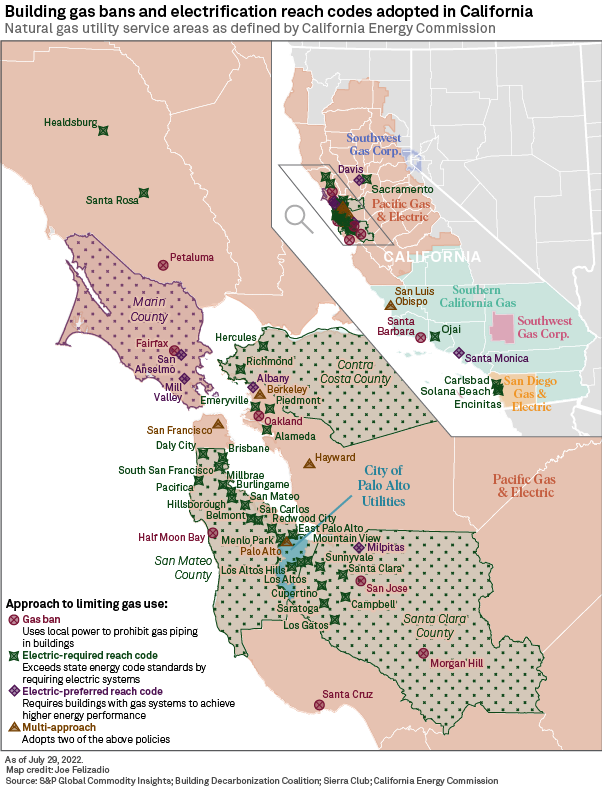
Tasked with creating a plan to achieve zero-carbon emissions in new residential and commercial buildings, the Los Angeles Department of Building and Safety recommended requiring all-electric new construction. |
California's most populous city took another step toward joining the dozens of Golden State municipalities that have restricted natural gas use in new buildings over the past three years.
The Los Angeles Department of Building and Safety, or LADBS, recommended that the city draft an ordinance requiring all-electric construction in most new buildings. The department made the recommendation in response to the Los Angeles City Council's directive to develop an implementation plan that would ensure that all new residential and commercial buildings achieve zero-carbon emissions.
LADBS concluded that electrification is a cost-effective way to achieve building decarbonization in Los Angeles and support the city's greenhouse gas emissions reduction goals. Combusting gas in buildings accounts for 25% of California's overall emissions and contributes to lower indoor air quality, according to the department.

The recommendation is another sign that Southern California cities are gravitating towards gas bans in new buildings, which have largely been concentrated in Northern California's San Francisco Bay Area.
The policy would severely impact the ability of Sempra subsidiary Southern California Gas Co. to grow its customer base. SoCalGas, which says it is the nation's largest gas utility by customer count, advocates for a combination of electrification, low-carbon fuel uptake and carbon management as "the most affordable, resilient, and technologically proven path to full carbon neutrality."
Potential ordinance details
LADBS advised requiring electric space and water heating, cooking, clothes drying and other end uses in most residential and commercial buildings beginning April 1, 2023. The department recommended extending the compliance deadline to June 1, 2023, for affordable housing projects.
The mandate would not apply to manufacturing and industrial facilities or hospitals and laboratories that require gas for specialized processes. Cooking appliances in commercial kitchens and emergency backup for life-safety systems would also be exempt. LADBS further recommended allowing gas equipment in guest homes built by homeowners currently served by the gas grid.
New hotels, motels and residential buildings with a to-be-determined number of units should also have to install solar thermal water heating systems for a portion of hot water demand, LADBS said. Exemptions would be available to buildings with sloped roofs, as well as those that use water recycling or reclamation systems.
Impacts on costs, rates
All-electric construction would be cost neutral on average compared to a mixed-fuel approach under both fixed and fluctuating time of use rates in a prototypical eight-story multifamily building in L.A., according to a study conducted by building and infrastructure consultancy Buro Happold for LADBS. Mixed-fuel buildings, which include fossil fuel hookups, would have "slightly lower" annual utility costs than all-electric buildings, the report found.
However, all-electric buildings were cheaper overall once Buro Happold factored in maintenance, equipment replacement and gas infrastructure costs. All-electric buildings also boast an average 27% energy savings over mixed-fuel buildings, the report said. Buildings that combine time of use rates, all-electric construction, load shifting and efficient systems would yield the greatest cost savings, Buro Happold found.
Developers would save an average $3,361 on gas piping and infrastructure by building all-electric low-rise multifamily homes, or $6,300 in single-family residences, according to cost-effectiveness studies by the California Public Utilities Commission. The commission voted in September to end the practice of socializing the cost of new gas hookups across a utility's rate base.
An all-electric mandate for new buildings "will likely have no significant effect" on gas utility rates because new construction represents just half a percent of L.A.'s building stock, LADBS said. The department noted that it is developing a decarbonization policy for existing buildings, which could require incentives to prevent bill increases as the city retrofits and electrifies that stock.
The Los Angeles Department of Water and Power, or LADWP, may have to build or upgrade electric distribution infrastructure and transformers for some new all-electric building developments, LADBS found. However, those upgrades would be necessary for many mixed-fuel buildings, it said. Further, a pending update to California's Building Energy Efficiency Standards will require developers to wire new residential buildings for easy conversion to all-electric heating and appliances beginning on Jan. 1, 2023, LADBS noted.
The department acknowledged that the transition would negatively impact natural gas and plumbing workers, though it said requiring solar thermal heating in multifamily buildings would offset some of the impact to plumbers.
LADBS requested that the city attorney work with the department to develop the ordinance. It also asked LADWP to explore developing financial incentives for installing solar thermal water heaters. It additionally directed staff to work with LADWP to leverage current and future rebate programs to help utility customers manage potential bill increases resulting from the policy.
S&P Global Commodity Insights produces content for distribution on S&P Capital IQ Pro.



